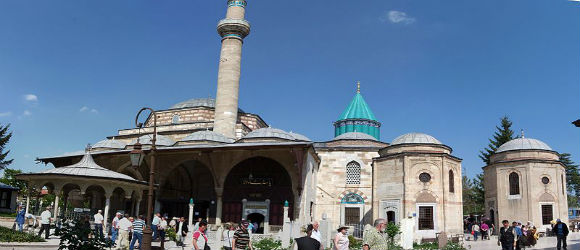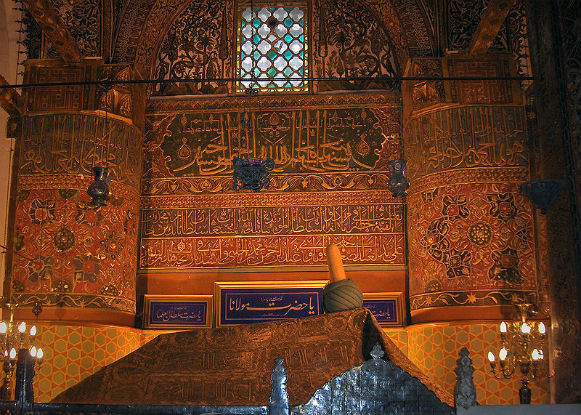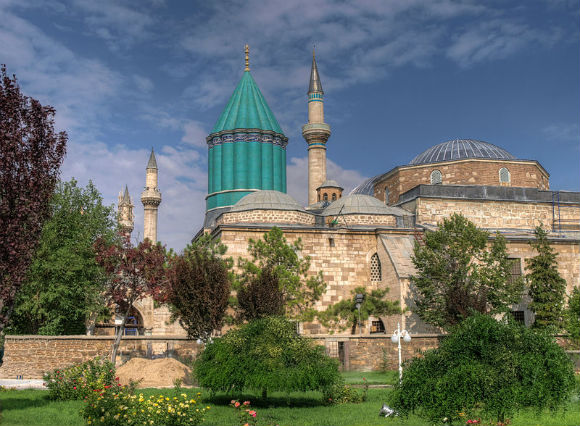The Mevlana Museum also known as the Green Mausoleum or Green Dome, is the original lodge of the Mevlevi Whirling Dervishes, a mystical Sufi Muslim group. It containes the tomb and shrine of the Mevlana, or Rumi, which remains an important place of pilgrimage.
History
Sultan ‘Ala’ al-Din Kayqubad, the Seljuk sultan who had invited Mevlana to Konya, offered his rose garden as a fitting place to bury Baha’ ud-Din Walad (or Bahaeddin Veled), the father of Mevlana, when he died in 1231. When Mevlana himself died on December 17, 1273, he was buried next to his father.
Mevlana’s successor Hüsamettin Çelebi built a mausoleum (Kubbe-i-Hadra) over the grave of his master. The Seljuk construction, under architect Behrettin Tebrizli, was finished in 1274. Gürcü Hatun, the wife of the Seljuk Emir Suleyman Pervane, and Emir Alameddin Kayser funded the construction.
The cylindrical drum of the of the dome originally rested on four pillars. The conical dome is covered with turquoise faience. Several sections were added until 1854. Selim I decorated the interior and performed the woodcarving of the catafalques.
A decree by Ataturk in September 1925 dissolved all Sufi brotherhoods in Turkey. On April 6, 1926, another decree ordered that the Mevlana mausoleum and dervish lodge be turned into a museum. The museum opened on March 2, 1927.
Special permission granted by the Turkish government in 1954 allowed the Mawlawi dervishes of Konya to perform their ritual dances for tourists for two weeks each year. Despite government opposition the order has continued to exist in Turkey as a religious body. The tomb of Rumi, although officially part of a museum, attracts a steady stream of pilgrims.
What to See
The dervish lodge (tekke) includes a semahane, where the ritual sema or whirling ceremony takes place, a sadirvan for ritual ablutions, a library, living and teaching quarters, and the mausoleum housing the tomb of Celaleddin Rumi, founder of the sect and later awarded the honorable title of Mevlana. His epitaph reads: “Do not seek our tombs on this earth – our tombs are in the hearts of the enlightened.”
The mausoleum room is highly ornamented with Islamic script and enameled reliefs, and contains the tombs of several of the more important figures of the dervish order. The main tomb enclosed behind a silver gate crafted in 1597 is that of Mevlana. The tomb of his father, Bahaeddin Veled, is upright and adjacent to his son’s, a position that signifies respect.
The adjoining room, or the semihane, is now a museum of Mevlana memorabilia displaying musical instruments and robes belonging to Mevlana, along with Selçuk and Ottoman objects like gold-engraved Korans from the 13th century. Among the fabulous ancient prayer rugs is the most valuable silk carpet in the world.
Mevlana Museum, Konya,




just had a half day to visit Konya.
this Museum is Konya's icon.
no camera allowed inside the museum and tomb. we must used plastic to cover our shoes (the plastic is provided in entrance)
also the museum is has a cafe beside.
Visit not just to see the beautiful architecture and splendid scenery, but to immerse yourself in a crowd of religious pilgrims, there to see the tomb of Rumi. Take the audio tour and learn about Rumi, whose thoughts on love, charity, and tolerance (yes, religious tolerance) are inspiring and seem to infuse the spirit of the place.
Amazing place, full of mysticism, with a rich and interesting museum and a beautiful mosque, home and sacred temple of the Islamic arm of Mevlana. The visit is culturally and spiritually aggrandizing.
Good way to find out about the history of the whirling dervishes. Lots of text to read as well as models and costumes
If you visit independently, then buy the audio guide – it really is worth it. The information given is thorough. Be prepared for lots of visitors as this is the place all visitors to Konya go to. We went because of the Whirling Dervish connection but went away with a much deeper appreciation of how the tradition came about.
It…
Well worth the effort. It's a magnificent museum and the entrance fee is very reasonable. Take your time and wander around each section, soak up the different skills and talents on display. Try to visit on Saurday night when the Dervish will perform.
As A Part Of Tour We Go To This Museum To Know The History About Sufi Islam.I Am Not A Muslim But Its Still Interesting Place To Visit In Konya.
Mevlana Museum is what I know this place as – never saw it referred to anywhere as the Green Mausoleum though there is no doubt a turquoise turret sits high above the leader of this sects burial site. Konya is a very conservative city and very different from anywhere else in Turkey I have visited so far.
Mevlana was a…
It houses the tomb of Sufi saint Rumi. It is neat clean and has peaceful happy vibes. Felt wonderful even without the whirling !!
We went here as part of a set tour but I wouldn't have wasted my time in Konya, if I had been able to choose. You can visit the tomb of Mevlana and his family and some rooms and see some codices written in Arabic. It was interesting to see how Turkish people were praying as if they were in…